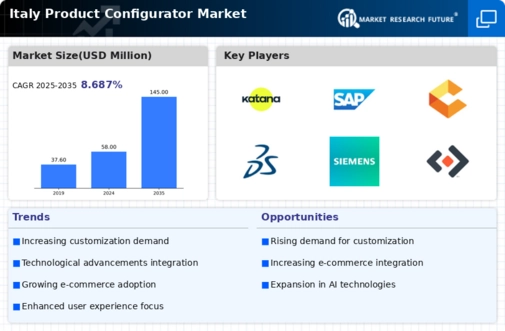Customization Demand Surge
The product configurator market in Italy experiences a notable surge in demand for customization options. Consumers increasingly seek personalized products that cater to their unique preferences and specifications. This trend is particularly evident in sectors such as automotive and fashion, where tailored solutions enhance customer satisfaction. According to recent data, approximately 70% of Italian consumers express a preference for customized products, indicating a significant shift in purchasing behavior. As a result, businesses are compelled to adopt product configurators to meet this growing demand, thereby driving innovation and competitiveness within the market. The product configurator market is thus positioned to thrive as companies invest in technology that facilitates customization, ultimately leading to enhanced customer engagement and loyalty.
Rising Consumer Expectations
Consumer expectations in Italy are evolving, with a growing emphasis on quality, speed, and personalization. The product configurator market is directly influenced by these rising expectations, as customers demand not only high-quality products but also the ability to customize them quickly and efficiently. This shift is particularly pronounced in sectors such as electronics and home goods, where consumers are willing to pay a premium for tailored solutions. Market analysis indicates that approximately 55% of Italian consumers prioritize customization in their purchasing decisions, compelling businesses to adapt their offerings accordingly. Consequently, the product configurator market must innovate to meet these expectations, fostering a competitive landscape that prioritizes customer satisfaction and engagement.
Increased Focus on User Experience
The product configurator market in Italy is increasingly characterized by a heightened focus on user experience. Companies recognize that a seamless and intuitive interface is crucial for attracting and retaining customers. As a result, businesses are investing in user-friendly product configurators that simplify the customization process. This focus on user experience is supported by research indicating that 80% of consumers are more likely to engage with brands that offer easy-to-navigate platforms. Furthermore, the product configurator market is evolving to incorporate feedback mechanisms that allow users to share their experiences, thereby driving continuous improvement. This emphasis on user experience not only enhances customer satisfaction but also contributes to brand loyalty, ultimately benefiting the market as a whole.
Shift Towards Digital Transformation
The ongoing digital transformation across various industries in Italy significantly impacts the product configurator market. Businesses are increasingly adopting digital tools to streamline operations and enhance customer interactions. This shift is driven by the need for efficiency and the desire to meet the expectations of tech-savvy consumers. As companies transition to digital platforms, the demand for product configurators rises, enabling them to offer seamless online experiences. Recent statistics indicate that over 60% of Italian companies are investing in digital solutions, which includes the implementation of product configurators. This trend suggests that the product configurator market is poised for substantial growth as businesses recognize the importance of digital engagement in maintaining competitiveness.
Integration with Advanced Technologies
The integration of advanced technologies such as artificial intelligence (AI) and augmented reality (AR) is transforming the product configurator market in Italy. These technologies enable businesses to offer immersive and interactive experiences, allowing customers to visualize their customized products in real-time. For instance, the use of AR in furniture design allows consumers to see how a piece will look in their home environment before making a purchase. This technological advancement not only enhances user experience but also increases conversion rates, as customers are more likely to finalize purchases when they can visualize their choices. The product configurator market is thus witnessing a shift towards more sophisticated solutions that leverage these technologies, potentially increasing market growth by an estimated 25% over the next few years.





















Leave a Comment